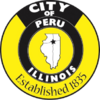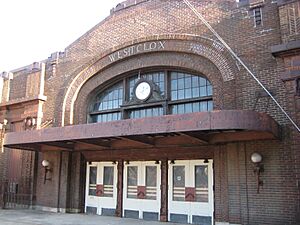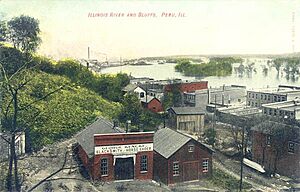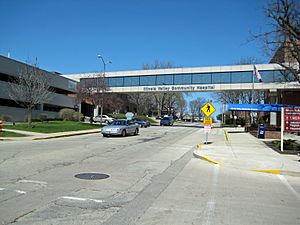Peru, Illinois facts for kids
Quick facts for kids
Peru
|
|||
|---|---|---|---|
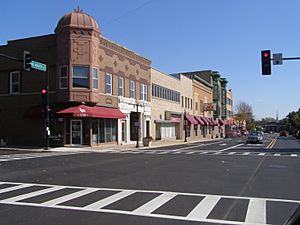
4th Street Looking East in Downtown Peru
|
|||
|
|||
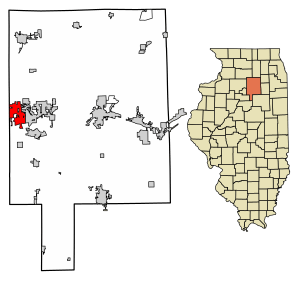
Location of Peru in LaSalle County, Illinois.
|
|||
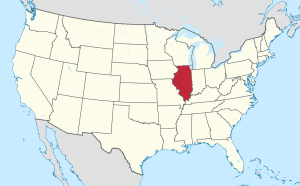
Location of Illinois in the United States
|
|||
| Country | United States | ||
| State | Illinois | ||
| County | Bureau, LaSalle | ||
| Townships | Peru, Dimmick, Hall | ||
| Area | |||
| • Total | 10.12 sq mi (26.21 km2) | ||
| • Land | 9.99 sq mi (25.86 km2) | ||
| • Water | 0.13 sq mi (0.35 km2) | ||
| Elevation | 640 ft (200 m) | ||
| Population
(2020)
|
|||
| • Total | 9,896 | ||
| • Density | 977.87/sq mi (377.57/km2) | ||
| Time zone | UTC−6 (CST) | ||
| • Summer (DST) | UTC−5 (CDT) | ||
| ZIP Code(s) |
61354
|
||
| Area code(s) | 815 | ||
| FIPS code | 17-59234 | ||
| GNIS feature ID | 2396189 | ||
| Website | City of Peru official website: http://www.peru.il.us | ||
Peru is a city located in LaSalle and Bureau counties in the state of Illinois, United States. In 2020, about 9,896 people lived there.
Peru is part of the Ottawa, IL Micropolitan Statistical Area. It is often called the "twin city" of LaSalle. Together, Peru and LaSalle form the main part of the Illinois Valley region.
Contents
History of Peru
The first person to settle in Peru was John Hays in 1830. The city was officially set up as a borough in 1838. It became a village in 1845 and then a city in 1851. The original town area was between West Street, 4th Street, and what is now Pine Street.
Peru as a River City (1831–1933)
When the first steamboat, Traveler, arrived in Peru in 1831, people hoped Peru would be the end point for the Illinois & Michigan Canal. However, LaSalle got that honor. Still, Peru became a very busy port for steamboats on the Illinois River.
Captain McCormick helped create the Five Day Line, which made very fast trips between Peru and St. Louis, Missouri. Some people even thought Peru would grow bigger than Chicago because of its great location by the river and railroads.
The area along Water Street, between the bluff and the river, became a large industrial zone. It was served by the Rock Island Railroad and Chicago Burlington and Quincy lines. These important transport routes, along with coal mining, helped Peru become an industrial center. Coal mining happened from 1857 until 1949.
Many businesses grew in Peru during this time. Some well-known companies included Maze Lumber, Maze Nails, Peru Plow and Wheel Works, and Illinois Zinc. Peru and LaSalle were sometimes called "Zinc City" because of the zinc industry.
People in Peru worked hard to improve their town. They even built a plank road northwest of town, which was a toll road meant to reach Dixon, Illinois.
Life in Peru was like two different stories: one for Water Street by the river and another for the town on top of the bluff. The city tried to connect these two parts. For example, they tried to make a horse and dummy railroad go from Water Street up to the bluff, but it was too difficult.
Peru as Clock City (1884–1980)
In 1884, the United Clock Company started in Peru. It later went out of business but was restarted with help from Frederick William Matthiessen as the Western Clock Company. By 1905, it was a big national company, making over 1 million alarm clocks each year. In 1909, they created the famous "Westclox" brand.
Westclox was known for taking good care of its workers. In 1917, it was one of the first companies to offer life insurance and have a safety committee. Later, they limited the work week, built a company park with sports courts, and even created housing and a school for watchmakers. In 1935, it was the safest company in the country.
During World War II, Westclox made special parts for the government. Over 600 of its employees joined the armed forces. At its busiest, the company made almost 2 million clocks and watches every year and had over 4,000 employees.
The Peru factory closed in 1980. This job loss caused the populations of LaSalle and Peru to drop quickly. Today, the old Westclox Administration Building is home to the Carus Corporation. The rest of the Westclox complex is being turned into a shopping area. You can also visit the Westclox Museum there.
Geography and Climate
Peru covers about 10.12 square miles (26.21 square kilometers). Most of this area is land, with a small part being water.
The city is located on the Illinois River. It is about 3 miles (4.8 km) west of where two major highways, Interstate 39 and Interstate 80, meet. Peru is also the western end of the old Illinois and Michigan Canal. Before the Illinois Waterway was built, boats could only travel up the Illinois River as far as Peru.
Starved Rock State Park, a popular place for tourists, is about 5 miles (8 km) southeast of Peru.
Weather in Peru
| Climate data for Peru, Illinois (1991–2020 normals, extremes 1901–present) | |||||||||||||
|---|---|---|---|---|---|---|---|---|---|---|---|---|---|
| Month | Jan | Feb | Mar | Apr | May | Jun | Jul | Aug | Sep | Oct | Nov | Dec | Year |
| Record high °F (°C) | 68 (20) |
72 (22) |
84 (29) |
94 (34) |
105 (41) |
107 (42) |
113 (45) |
106 (41) |
103 (39) |
93 (34) |
82 (28) |
70 (21) |
113 (45) |
| Mean daily maximum °F (°C) | 30.0 (−1.1) |
34.5 (1.4) |
47.5 (8.6) |
60.9 (16.1) |
72.5 (22.5) |
81.3 (27.4) |
84.0 (28.9) |
82.2 (27.9) |
76.9 (24.9) |
63.9 (17.7) |
48.4 (9.1) |
35.5 (1.9) |
59.8 (15.4) |
| Daily mean °F (°C) | 22.0 (−5.6) |
26.0 (−3.3) |
37.4 (3.0) |
49.3 (9.6) |
60.9 (16.1) |
70.3 (21.3) |
73.4 (23.0) |
71.5 (21.9) |
64.8 (18.2) |
52.5 (11.4) |
39.2 (4.0) |
27.7 (−2.4) |
49.6 (9.8) |
| Mean daily minimum °F (°C) | 14.0 (−10.0) |
17.6 (−8.0) |
27.3 (−2.6) |
37.7 (3.2) |
49.2 (9.6) |
59.4 (15.2) |
62.8 (17.1) |
60.8 (16.0) |
52.6 (11.4) |
41.1 (5.1) |
30.0 (−1.1) |
19.9 (−6.7) |
39.4 (4.1) |
| Record low °F (°C) | −26 (−32) |
−24 (−31) |
−11 (−24) |
13 (−11) |
25 (−4) |
37 (3) |
42 (6) |
37 (3) |
25 (−4) |
14 (−10) |
−5 (−21) |
−21 (−29) |
−26 (−32) |
| Average precipitation inches (mm) | 1.81 (46) |
1.77 (45) |
2.28 (58) |
3.77 (96) |
4.49 (114) |
4.62 (117) |
3.89 (99) |
3.70 (94) |
3.41 (87) |
3.50 (89) |
2.71 (69) |
2.10 (53) |
38.05 (966) |
| Average snowfall inches (cm) | 8.6 (22) |
5.5 (14) |
4.0 (10) |
0.6 (1.5) |
0.0 (0.0) |
0.0 (0.0) |
0.0 (0.0) |
0.0 (0.0) |
0.0 (0.0) |
0.2 (0.51) |
0.9 (2.3) |
8.7 (22) |
28.5 (72) |
| Average precipitation days (≥ 0.01 in) | 9.9 | 7.8 | 10.8 | 12.4 | 12.8 | 10.8 | 9.4 | 9.5 | 7.8 | 9.5 | 10.0 | 10.2 | 120.9 |
| Average snowy days (≥ 0.1 in) | 6.3 | 4.7 | 2.4 | 0.4 | 0.0 | 0.0 | 0.0 | 0.0 | 0.0 | 0.0 | 1.1 | 5.4 | 20.3 |
| Source: NOAA | |||||||||||||
Peru has a climate with four distinct seasons. Summers are warm, and winters are cold with snow. The city gets a good amount of rain throughout the year.
Population and People
| Historical population | |||
|---|---|---|---|
| Census | Pop. | %± | |
| 1850 | 1,279 | — | |
| 1860 | 3,139 | 145.4% | |
| 1870 | 3,650 | 16.3% | |
| 1880 | 4,632 | 26.9% | |
| 1890 | 5,550 | 19.8% | |
| 1900 | 6,863 | 23.7% | |
| 1910 | 7,984 | 16.3% | |
| 1920 | 8,869 | 11.1% | |
| 1930 | 9,121 | 2.8% | |
| 1940 | 8,983 | −1.5% | |
| 1950 | 8,653 | −3.7% | |
| 1960 | 10,460 | 20.9% | |
| 1970 | 11,772 | 12.5% | |
| 1980 | 10,873 | −7.6% | |
| 1990 | 9,302 | −14.4% | |
| 2000 | 9,820 | 5.6% | |
| 2010 | 10,295 | 4.8% | |
| 2020 | 9,896 | −3.9% | |
| Decennial US Census | |||
In 2020, Peru had a population of 9,896 people. There were 4,482 households in the city. About 25.6% of these households had children under 18 living there.
The population is made up of different groups. Most people are White, but there are also African American, Asian, Native American, and other racial groups. About 9.43% of the population is Hispanic or Latino.
The median age in Peru is about 49.2 years old. This means half the people are younger than 49.2, and half are older.
The average income for a household in Peru was $52,635. For families, the average income was $73,477.
Economy and Jobs
Peru has several business areas. The largest one is where I-80 and IL-251 highways meet. There are also smaller business areas along the US-6 Corridor, including downtown Peru.
Some of the biggest employers in Peru include the Peru Mall, Illinois Valley Community Hospital, Walmart, James Hardie, and Target.
Peru is home to some very old companies. American Nickeloid, which started in 1898, has its main office here. W.H. Maze Co., a lumber and nail company, started in 1848. Maze Nails is one of the few nail makers left in America. The Carus Chemical Company, started in 1915, is also in Peru. It is one of the world's largest makers of potassium permanganate.
In 2021, a baseball team called the DuPage Pistol Shrimp moved to Peru. They became the Illinois Valley Pistol Shrimp. This team plays in the collegiate Prospect League.
Education in Peru
Students in Peru attend several schools:
Elementary Schools
- Peru Public Schools
- Peru Catholic School
- LaSalle-Peru Christian School
High Schools
- LaSalle-Peru Township High School
- St. Bede Academy
- LaSalle-Peru Christian School
Transportation
The city of Peru operates the Illinois Valley Regional Airport. This airport helps people travel to and from the area.
Famous People from Peru
Many notable people have connections to Peru, Illinois:
- John Virginius Bennes, an architect
- William P. Bettendorf and Joseph W. Bettendorf, important business leaders
- Zez Confrey, a composer and pianist
- Grenville Dodge, a Civil War general and railroad builder
- Mike Goff, an offensive lineman for the Kansas City Chiefs football team
- J. A. Happ, a baseball pitcher for the St. Louis Cardinals
- Wilhelmina Kott, the oldest person ever from Illinois, was born here
- Maud Powell, a violinist who won a Grammy Lifetime Achievement Award
- Howard C. Ryan, a Chief Justice of the Illinois Supreme Court
- William Donald Scherzer, who invented a type of bridge called the Scherzer Rolling Lift Bridge
See also
 In Spanish: Peru (Illinois) para niños
In Spanish: Peru (Illinois) para niños



